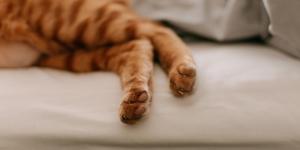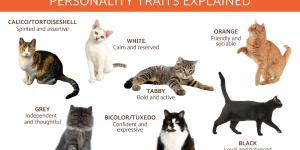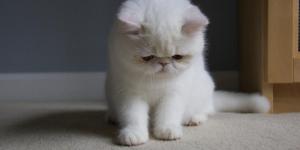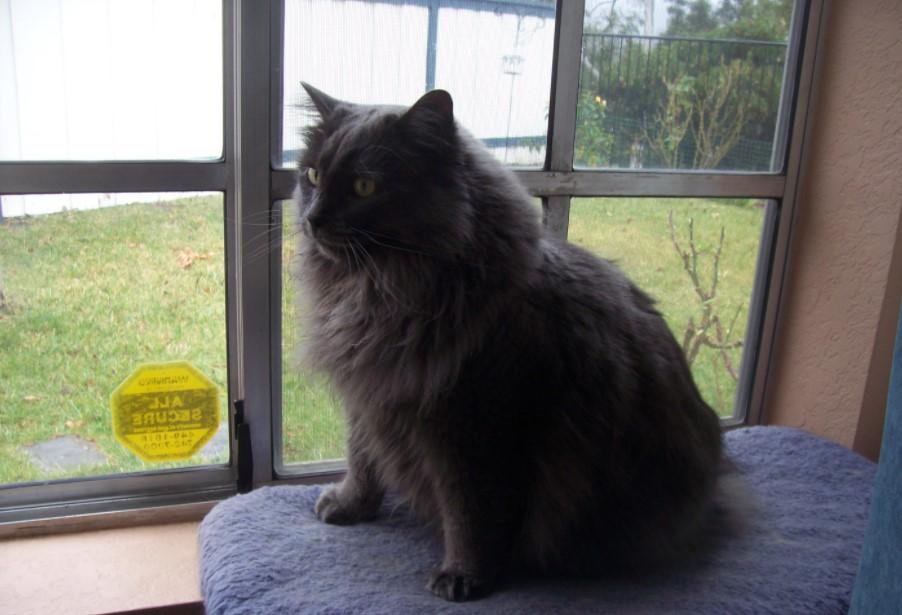Cymric Cat Breed

Cymric cats are actually longhair Manx cats. Both hail from the same British Isle, though the growing popularity of the Cymric is more recent. Between the 1960s and 1970s, long-haired Manx cats began to be bred. A short time later, the resulting specimens ended up being considered as the Cymric breed, being officially recognized by several feline associations, including the FCI. Both have an very short tail, an issue which can cause health problems.
The Cymric cat is a stocky cat due to its wide bones and long, thick coat. They have an appearance that makes them look like a fluff ball because they are so round, but at the same time they are agile, playful and very good jumpers. They are endearing cats, very friendly, sociable and will like to get your attention to play, run around or simply follow you around the house. Keep reading this AnimalWised breed file to find out more about this particular variant of Manx cats, specifically we look at the origin, characteristics, temperament and more of Cymric cats.
- Europe
- Isle of Man
- Category III
- 7-11
- 11-13
- 13-17
- 17-22
- 22-30
- 8-10
- 10-15
- 15-18
- 18-20
Origin of the Cymric cat
The Cymric cat comes from the Isle of Man, located in the Irish Sea between Ireland and Great Britain. Their origin lies in the 18th century, just like the Manx cats. Natural reproduction of cats in this small territory allowed the mutation of the Cymric gene to be perpetuated. It is this gene which causes them to have a shortened or absent tail.
Cymric cats are considered longhaired Manx cat breeds, as both breeds have been around since the mutation appeared and people started breeding them. Specifically, Leslie Falteisek, an American breeder, and the Canadian Blair Wrighten, in the 1960s decided to separate and pair the kittens from litters of Manx cats that were born with long hair. This particularity was thus extended to the point of considering the name Cymric, which means "Wales" in Celtic, in honor of the place of origin of these cats (between Ireland and Wales).
In 1976, the Canadian Cat Association was the first to accept this breed for championships and in 1979 it was officially recognized by TICA (The International Cat Association).
Characteristics of the Cymric cat
The Cymric cat is very robust, with a head, eyes, paws and hips that are round. Their body is medium, short and strong. Adult males can weigh between 4 and 5 kg (8.8-11 lb), with females weighing between 3 and 4 kg (6.6-8.8 lb).
Their head is round, large and with protruding cheeks. The nose is medium, straight and short. The ears are medium, with a wide base and a round tip. The eyes are round and large, with color matching the color of the coat. They are short-legged, wide-boned, and have shorter front legs than hind legs.
Types of Cymric cats
The main characteristic of this cat breed is its short or absent tail. Depending on their length, Cymric cats are characterized by:
- Rumpy: no tail.
- Riser: tail of less than three vertebrae.
- Stumpy: more than three vertebrae, but not normally more than 4 centimeters.
Cymric cat coat colors
The hair of these cats is semi-long, dense and thick with a double layer. The hair is generally silky, soft and shiny. It can be of multiple colors and patterns, such as:
- White
- Blue
- Black
- Red
- Cream
- Silver
- Coffee
- Tabby
- Bicolor
- Tricolor
This breed can also be tortoiseshell. Learn more with our articles on tortoiseshell cats and different types of tabby cats.
Cymric cat character
Cymric cats are characterized by being very calm, sociable and intelligent. They show a strong bond with their caregivers. They are agile despite being so robust and enjoy running, climbing and playing with everything in their path. Being so outgoing, it is easy for them to coexist with children, other animals and even strangers, whom they will not hesitate to greet. They will even try to play with them, something not common to all cats.
They have a particular way of moving, resembling the movement of a bowling ball due to their voluminous coat and rounded shape. They especially like heights and it is normal to find them on quite high places. For this reason, we need to be careful of high-rise syndrome in cats. This breed especially hates water. There are people who believe that it is because they were created on an island surrounded by it. In addition, they are capable of burying objects and then unearthing them.
Cymric cats like us to keep them active with stimuli and games. They are so faithful that these cats follow their caregiver wherever they go. If you have a garden, they will not hesitate to go out to browse and demonstrate their keen hunting skills.
Cymric cat care
Due to their double coat of hair and its length, these cats require frequent brushing. If possible, we should brush them every day. If not, we need to brush at least three times a week. In addition to favoring the cat/guardian bond, it reduces the risk of hairballs forming. This brushing should be done with metal-tipped combs and should be reinforced in the spring and autumn molting seasons. Oral administration of malt paste for cats can also help in the prevention of hairball formation.
The hygiene of their ears and mouth must be maintained, as well as dewormed and vaccinated like all feline breeds. From the age of seven, you should go for a kidney function and blood pressure checkup. This checkup will also examine for the presence of any disease of the breed or another that can affect felines.
With regard to diet, you must ensure all the nutrients and provide a feed of good quality. It needs a high amount of protein and properly controlled portions to avoid obesity, since they are usually very voracious. They are very active, but it is necessary that we maintain their physical condition through games that make them stay in shape.
Cymric cat health
In the Manx cat breeds there is the M gene. This is responsible for the mutation in the length of the tail. It presents a dominant management, meaning those that present one of the two dominant alleles (Mm) or the two dominant alleles (MM) for the gene, will be born without a tail. However, MM die before birth due to severe damage to the nervous system. Manx and Cymric cats are Mm, as kittens of these MM breeds are prevented from being born by their fatal development. Ideally, one of the parents is Cymric and the other is a type of long-tailed cat to ensure that it does not have these genes. Alternatively, both parents can be Cymric, but do not have the total absence of a tail.
Common diseases of Cymric cats
Some Cymric cats can present health problems derived from their deformed spine due to the absence of a tail, such as the presence of arthritis at any age, spinal problems or defects in the hip bones.
20% of Cymric and Manx cats present Manx syndrome after 4 months of age. This is congenital and is characterized by various signs due to the mutated gene that excessively shortens the spine. Abnormalities in the spine or spinal cord such as spina bifida can develop. In turn, these cause incontinence and affectation of the caudal and sacral nerves, but also harm the bladder, intestine and hind limbs.
Kittens with this syndrome have a life expectancy of less than 5 years. Sometimes, the deformed caudal vertebrae of the Cymric can cause them discomfort and sometimes cause an obstruction of the anal canal.
Other Cymric Cat Health Problems
Other diseases present in this breed are:
- Corneal dystrophy
- Intertrigo (infection of skin folds)
- Eye infections
- Ear infections
- Obesity
- Bone problems
- Diabetes
Cymric cats can also develop any of the diseases that affect cats in general, so routine visits to the vet are important. So it disease prevention through vaccination and deworming. They can have the same quality of life as any healthy cat and can reach up to 15 years of age.
Where to adopt a cymric cat
If we are interested in adopting a cat of the Cymric breed, we should know it is difficult. This is especially so if we do not reside in Great Britain or the United States. The best thing will always be to go to protectors, shelters or ask in associations about this breed and its possibilities of adoption.
Before thinking about adopting a Cymric cat, we must inform ourselves well about the breed. We need to know what their character is like and how our lifestyle fits with them. For example, since they are such a playful and affectionate cat, they are not for caregivers who are unable to spend the time to stimulate them properly, both physically and mentally.
Cymric Cat Breed photos










